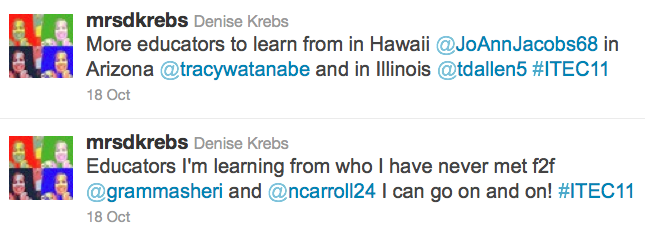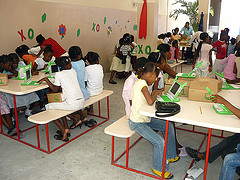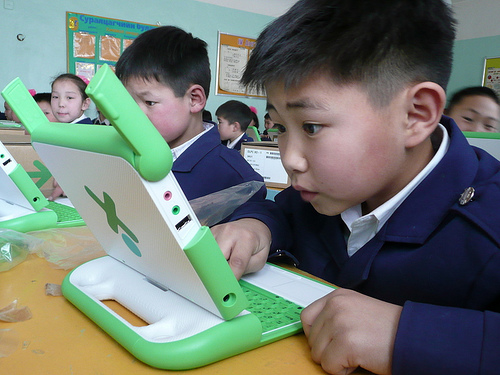I started this blog post on October 18, 2011, and it’s been sitting ever since. It was first titled “ITEC11 Day 2.”
This morning, eight months after I started it, I was reminded of Steve Hargadon’s important words when I responded to an undergraduate student’s question about what I meant by “the reinvention of education.”
I don’t lightly toss around words like “reinvention” and “revolution”, “shift” and “shakeup.” I really mean them (and other rebellious word choice) when I describe what is happening in education.
I just completed a transformational year in my teaching career. After joining the conversation the year before, I went to ITEC11 (Iowa Technology in Education Connection) last fall and was inspired to rethink how we do education.
My eight-month old notes follow…
The second day of ITEC11 was as stimulating as the first. It was educational, in the best sense of the word. My favorite speaker was Steve Hargadon, founder of Classroom 2.0, among other things. He shared amazing possibilities. Here is a link to EduVision, where you can find Steve’s keynote. Search for “ITEC Day 2 Keynote Steve Hargadon 10-18-11.”
Here is an outline of his talk, with my occasional reflections in italics.
He had Three Things to Share With Us…
- An Important Idea
- A Platform
- A Framework
The Important Idea – YOU MATTER!
You matter a lot!
Search YouTube for Angela Maiers & You Matter
We were asked to share with someone sitting near us a passion, a skill or a talent we had. It was exciting to hear the buzz around the room.
“Each of you is uniquely valuable in this world,” he said. Not only do you matter individually, but collectively. Steve explained that tech changes have led to culture changes that are leading to educational changes. As teachers interested in technology, that makes us matter collectively. He likened us to super heroes, in fact.
He asked us to discuss with another neighbor, “What is the main purpose of education?” I said,

We have a new platform. No longer do we have to rely on the institutional or professional narrative. There is a new shift in voice and a shift in power. He used the protests in Egypt as an example of the shift in power in governance. Wisconsin, Occupy Wall Street, are examples. New conversations and new voices are being heard in those big-issue conversations.
Web 1.0, the first Internet, was all about reading, receiving, and researching. It was a lot like books.
The new Internet, or Web 2.0, is about contributing, collaborating, and creating – “Web 2.0 is the web as a collaborative platform, a framework for user contribution.”
“The Internet has become an unparalleled platform for learning AND initiative, participation, productivity and creativity…most of which take place outside of formal institutions.”
Name an educator you learn from whom you have never physically met. Now, more than ever, what we are learning is coming from peers rather than experts on stage.
Then Steve asked us to discuss with a neighbor the “ways the Internet is changing our culture that will profoundly impact how we think about education.” He summarized these three ways:
1. How we find, create and consume information
Education is conversation, not content. So, to fight the avalanche of content overload, create more content. We have online learning and flipped learning now. The Internet is more than just reading and researching.
Learning is creation, not memorization.
Learning is about sharing knowledge, rather than protecting your knowledge.
A great example was when he mentioned the buzz in the room as everyone was sharing their knowledge about what education meant to them. The fact that there was more discussion and, as it were, an “avalanche of content” made the learning more real, not less so. We don’t have to consume all the knowledge, we can share knowledge and join in on a more intimate level with others who are sharing knowledge. As we have heard often in recent years, there is no longer the sage on the stage, but the guide on the side. That’s how I felt Steve was to us–a guide reminding us of the importance of real-life education.
2. How we connect with others
From just local connections, to global connections.
This is an important way that my class and I are involved in connecting. We’ve gone from just having each other and the people in our building to have unlimited access to friends, colleagues, and experts.

3. How we get things done
When we balance structure and freedom, we unleash individual energy and potential.
We go from control to liberation. We educate to unleash individual energy and potential. This is a change from the factory model we’ve been doing for over 100 years. Steve refers to the factory model of education as broken.
Back to June, 2012…
Mary asked this morning, “by ‘reinvention’ do you mean more technology involved with student’s daily lessons/learnings?” Great question! And an easy assumption to make in this era. Perhaps when I started on this journey a couple years ago I may have meant just that.
Now, I realize it’s so much more than that. I’m learning something new every day about how school can be more relevant, students can have freedom to be passionate learners, and teachers can get out of their way and be the chief learner in the classroom. (Genius hour is one of the exciting ways my students and I are practicing this transformation in education!)
Good thing I’m the chief learner in my classroom! There is lots to learn!



